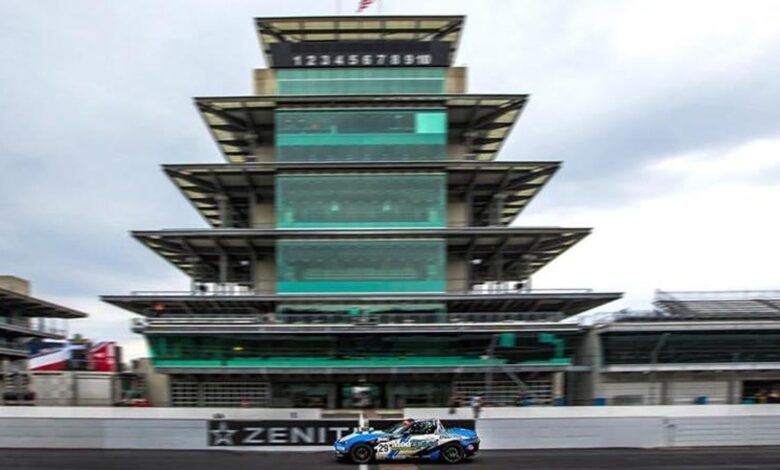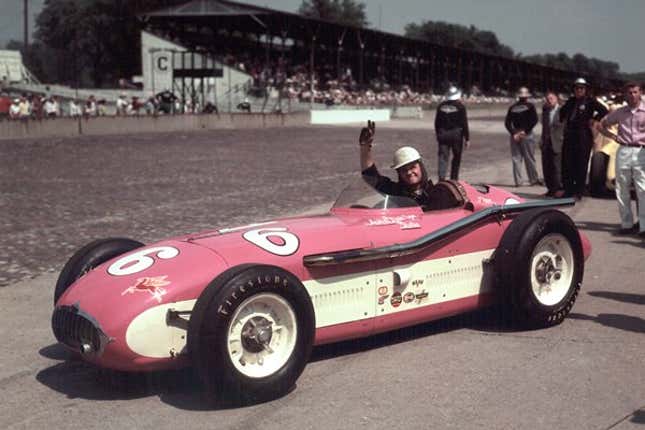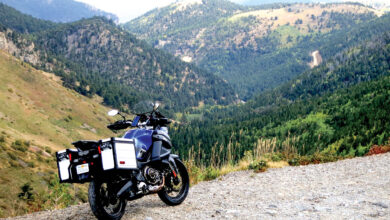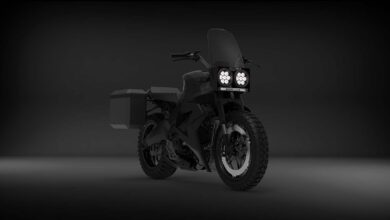Could A Mazda Miata Win The 1959 Indianapolis 500?

When car enthusiasts get together in groups, it’s inevitable that the bench racing hypotheticals will start flying. If Betty White was driving a Viper, do you think you could beat her in a race driving your Toyota Celica? Would Michael Schumacher in his prime beat Fangio if they were both driving the same car? How far back would you have to go for your race car to be fast enough to qualify for the Indy 500? That last one has been my favorite bench race query for over a decade, and it always gets my mind working.
A friend’s father once told me he had a C2-generation Corvette “with an experimental Can Am motor” that turned a lap at Indy “fast enough for pole” that year. It’s total bullshit, and definitely not possible, because Indy roadsters were pretty damn fast by the mid-1960s, and Corvettes, uh, weren’t. But could a C8 Corvette qualify for the 1966 Indy 500? Yeah, I bet it could.
With advances in aerodynamics, tires, and reliability, modern road cars are faster than ever before, and even faster than the most bonkers racing specials of yesteryear. I will probably end up doing more of these in the future, but figured I would start with a pretty simple one. If you bought one of Mazda’s $60,000 MX-5 Cup race cars, based on the standard Miata drivetrain and bodywork, what’s the most modern Indianapolis 500 Mile Race that you could win outright? And how many years later would you be kicked out on bump day?
Let’s do some math!
First of all, let’s determine what an MX-5 Cup car can do. These cars actually raced at Indianapolis in 2017, but the series used the road course, so the data from that race isn’t particularly useful. To figure out our MX-5 Cup’s top speed, let’s look to the recent race at Daytona International Speedway. Below is an onboard video from Gresham Wagner’s race one victory. The car’s data recorder shows a maximum speed of 146-ish miles per hour for the MX-5 Cup, but that’s running in a pack in the draft, so let’s say our max speed for solo qualifying at Indy would be around 140 miles per hour.
Given the ability to set the car up correctly for the four left-hand turns at the brickyard, the right tires to last a full stint at speed, and we’ll allow a little bit of downforce if necessary, I wouldn’t doubt that an MX-5 Cup could go flat out at Indy for the full lap, so we’ll say our theoretical average qualifying speed over three flying laps would be exactly 140.0 miles per hour.
The last year that our theoretical MX-5 Cup would qualify for pole at the Indy 500 is 1955, matching polesitter Jerry Hoyt’s 140.045 pole. Okay, so we’re on pole, but do we have a shot at winning?
Back then Indy roadsters needed to pit for fuel three times in the 500 mile race, meaning they could go 125 miles, more or less, on a full tank. An MX-5’s fuel tank is 11.9 gallons, meaning we’d have to achieve at least 10.5 miles per gallon at V-max. It isn’t necessarily RPM that determines fuel consumption, so much as it is load, and a Miata is going to be under serious load at 140 miles per hour. It’s rated at 30 MPG combined, so I think it could possibly go 125 miles on a tank.
Even still, we’ll be conservative and say the MX-5 needs an additional stop over an Indy Roadster to complete the 500. Four stops in 500 miles. In those days Indy pit stops saw the car stationary for around 25 seconds each stop, which is probably a bit longer than a well-oiled machine running a fuel dump and tire change on the Miata. I’m going to say that the MX-5 could brake from speed quicker than the Roadster, and accelerate back to V-max quicker than the long-gear Roadsters could, so overall time lost in the pits is going to be about equal for the Miata and the competitors at Indy. It washes out, pit stops won’t be the thing that kills our Miata’s win.

Bob Sweikert (above) won the 1955 Indy 500 in his pink Zink special with an average speed of 128.209 miles per hour. Given four stops at 20 seconds each, plus faster acceleration and braking, we’ll spend about 120 seconds of the race not running flat out. Stick it in top gear and put your foot to the floor, you’ll be stuck at 140.0 miles per hour for 100 mile stints. And if you catch a draft, you might even run faster than that. I think we’re in with a shot to win the 1955 Indy 500 from pole position in a 2024 Mazda MX-5 Cup car.
Our finishing time, after pit stops, assuming nothing went wrong, would be three hours, 36 minutes, and 12 seconds. Sweikert’s winning time in 1955 was three hours, 53 minutes, and 24 seconds. We won by 17 minutes!
So with a qualifying speed of 140 miles per hour, and a race average speed of 138.76 miles per hour, we can look to history to determine a few things.
The last Indy 500 we could qualify on pole for was 1955.
The last Indy 500 we could win based on our average time to finish was 1959.
Though we might come out on top in a 1960 photo finish against Jim Rathmann’s Ken-Paul Special, which averaged 138.767 miles per hour in the race, we wouldn’t have run a fast enough qualifying lap to make it into the big show. The slowest qualifier in 1960 was Jim McWithey’s Epperly-Offenhauser, which ran a 140.37 MPH in qualifying, and retired on lap 60 with brake failure.
Obviously this is all in fun, and there are a hundred thousand different variables that would have to go exactly our way in order for this to happen. But, if you ever get the opportunity to travel to 1959, and you can bring a 2024 Mazda MX-5 Cup with you, try to win the Indy 500. You just might.
Now I’m curious if a new Porsche GT3 Cup could beat the 1970 Porsche 917 to win Le Mans… That’s a question for some other time.




